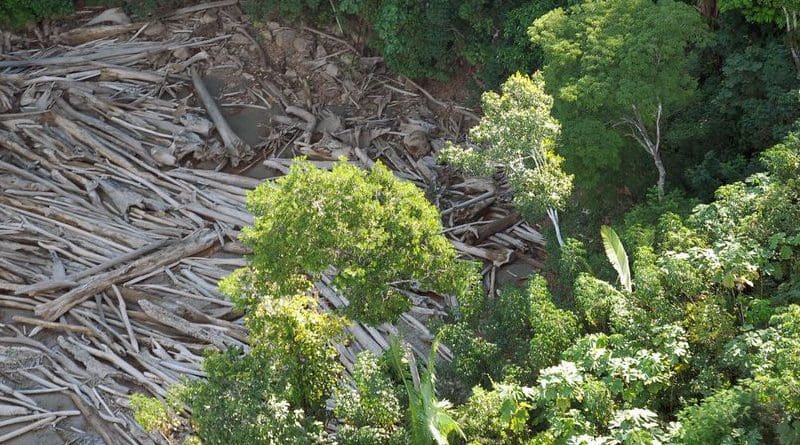Brazilian Amazon: Deforestation In Indigenous Territories Caused Emission Of 90 Million Metric Tons Of CO2 In 2013-21
Deforestation in Indigenous Territories (ITs) in the Brazilian Amazon caused the emission of 96 million metric tons of carbon dioxide (CO2) between 2013 and 2021, modifying the forest’s role as a carbon sink in these areas. Emissions in the last three years of the period (2019-21) accounted for 59%, reflecting intensification of the destruction.
The data comes from a research project led by Brazilians and published in an article in Scientific Reports. The authors show that deforestation in ITs totaled 1,708 square kilometers (km²), or 2.38% of total deforestation in the Brazilian Amazon in the period. In an analysis of 232 ITs, they found that annual deforestation averaged 35 km², increasing 129% between 2013 and 2021. The increase was 195% in the last three years of the period.
Alarmingly, the article also shows that the distance of deforested areas from the borders of the ITs concerned increased significantly in the period, rising 30% from 6.80 km to 8.87 km on average.
“In absolute numbers, the areas deforested in these ITs may not seem so large, but ITs are supposed to be environmentally protected, so the impact is all the greater. In addition to the destruction of nature, deforestation brings other problems in its wake, such as diseases and threats to the survival of isolated Indigenous communities. A recent case involved the Yanomami, many of whom died owing to encroachment by wildcat miners [garimpeiros],” Celso H. L. Silva-Junior, first author of the article, told Agência FAPESP. He is a professor in the Program of Graduate Studies in Biodiversity and Conservation at the Federal University of Maranhão (UFMA).
Considered an efficient forest conservation model, ITs have come under growing pressure from illegal alluvial panning and mining operations. The increase in deforestation, partly driven by setbacks such as the reversal of government policy on the rights of Indigenous communities, endangers the Amazon’s crucial role as a store of carbon. Tropical forests are key ecosystems in mitigating the adverse effects of climate change, acting as carbon sinks as long as they are left alone. Extensive logging, burning and clearing, however, can convert the areas in question into major sources of carbon emissions. Hence the importance of ITs in fostering conservation and combating deforestation.
“We should bear in mind that ITs are fundamental for Brazil to be able to meet its environmental targets and mitigate the impact of climate change. Conservation of the forest and rivers in these areas is essential. The law must be enforced so that they continue acting as a force field to protect the standing forest and the traditional communities who live in them,” said Guilherme Mataveli, a co-author of the article. Mataveli is a researcher in the Earth Observation and Geoinformatics Division (DIOTG) of Brazil’s National Space Research Institute (INPE) and has a postdoctoral scholarship from FAPESP.
The study also received funding from the Research Center for Greenhouse Gas Innovation (RCGI), an Engineering Research Center (ERC) established by FAPESP and Shell at the University of São Paulo (USP), and via a Thematic Project linked to the FAPESP Research Program on Global Climate Change (RPGCC).
In an article published last year in Science, Mataveli had already warned that growing deforestation in ITs endangered Brazil’s ability to meet its targets. Brazil promised to restore and reforest 12 million hectares of forest by 2030, and to achieve zero net carbon emissions by 2050, as part of its Nationally Determined Contribution targets under the 2015 Paris Agreement.
A third study conducted by scientists in the same group highlighted the expansion of wildcat mining activities in ITs in the Legal Amazon, an area spanning nine Brazilian states defined by federal law for environmental protection and developmental purposes. All mining in these areas is illegal. In the period 1985-2020, it increased 1,217% from 7.45 km² to 102.16 km². The overwhelming majority (95%) took place in the Kayapó, Munduruku and Yanomami ITs in Pará and Roraima states.
Concentration
In the latest study, deforestation increased in 42% of the ITs analyzed, significantly so in 20, from Arara in Pará with a rate of 0.02 km² per year to Apyterewa, also in Pará, with 8.58 km² per year.
On the other hand, deforestation decreased in 11% of the ITs analyzed, significantly in five. They included Alto Turiaçu (Maranhão state), home to some 1,500 members of the Awa Guajá, Ka’apor and Tembé communities.
“The focus of the article was the threats to Indigenous Territories, but this decrease was an interesting finding. In the case of Maranhão, for example, the Indigenous communities achieved this positive result because they have initiatives of their own to combat deforestation, such as groups who patrol the area as forest guardians,” Silva-Junior said.
He noted that the team of researchers was multidisciplinary, with two anthropologists providing different angles on the topic: Maycon Melo, from the Program of Graduate Studies in the Environment at CEUMA University (Maranhão), and Bárbara Maisonnave Arisi, from the Free University of Amsterdam (VUA, Netherlands).
Recommendations
The article ends with six public policy recommendations to stop deforestation in these areas: strengthening enforcement authorities; repealing laws and measures that have caused environmental degradation; creating a 10 km buffer zone between ITs and mining areas or high-impact projects; supporting sustainable land-use initiatives, including ecosystem restoration; more investment in monitoring by remote sensing, including new systems with improved frequency and scale; canceling all Rural Environmental Registrations (CAR) inside ITs; and strengthening FUNAI, the federal agency responsible for guaranteeing the rights of Indigenous communities, with increased funding and staffing.
This year, lawyer Joenia Wapichana became the first Indigenous person ever appointed to head FUNAI.

